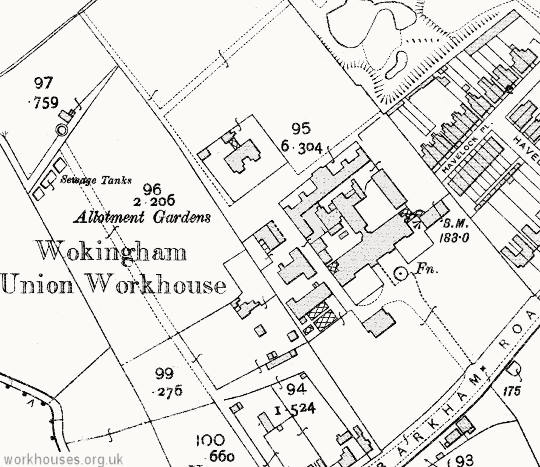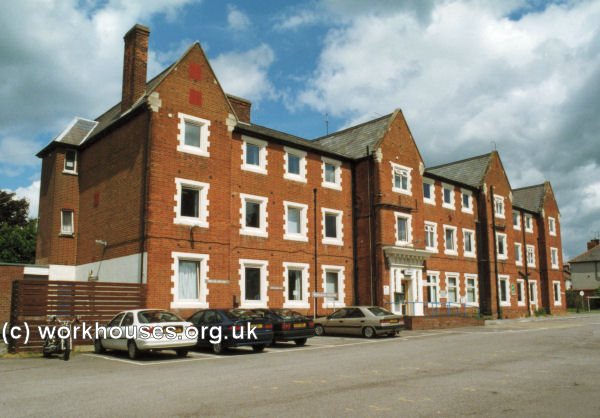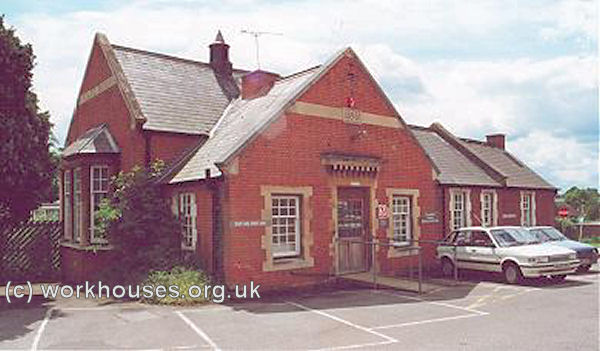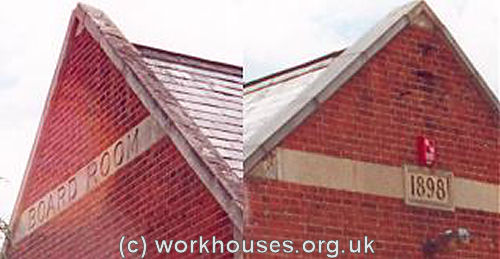Wokingham, Berkshire
Up to 1834
Wokingham had a workhouse by the 1760s, located at what is now 22 Denmark Street. An inventory in 1769 included tableware for up to eighteen inmates, but only five beds in the establishment. In 1777, the Wokingham Town workhouse was said to be able to house up to fifty inmates.
In the same year, workhouses were in operation at Shinfield (for up to 42 inmates), Wargrave (50), and Woodley and Sandford (50).
Wargrave's workhouse was on Victoria Road, Wargrave. In 1832, it had twenty-seven inmates, of whom twelve were under the age of 20.
The Shinfield workhouse was at Great Lea Common.
The Woodley and Sandford premises were at Cobblers' City, near the present-day junction of Headley Road East and Tipping Lane.
After 1834
Wokingham Poor Law Union was formed on 1st August 1835. Its operation was overseen by an elected Board of Guardians, 20 in number, representing its 16 constituent parishes as listed below (figures in brackets indicate numbers of Guardians if more than one):
County of Berkshire:
Arbourfield [Arborfield], Barkham, Broadhinton Liberty, Earleigh (Earley) Liberty, Finchampstead, Newland Liberty, Ruscomb, Sandford and Woodley, Shinfield (2), Sonning, Swallowfield [2 parts] (2), Wargrave (2), Whistley Liberty, Winnersh Liberty, Wokingham (3).
Later Additions (all from 1894): Hurst St Nicholas, Remenham, Twyford.
The population falling within the Union at the 1831 census had been 11,888 — ranging from Ruscomb (population 160) to Wokingham itself (3,139). The average annual poor-rate expenditure for the period 1832-35 had been £8,153.
The new Wokingham Union initially made use of the former Wargrave parish workhouse, for the upgrading of which the Poor law Commissioners authorized an expenditure of £1,390. However, a report by Edwin Chadwick in 1846 found that conditions were too cramped to allow proper segregation of the different classes of inmate, rooms were damp and badly ventilated, and there was a lack of infirmary and fever wards. Despite its apparent major shortcomings, the building was subsequently converted for use as the Reading and Wokingham District School.
A completely new workhouse for 250 inmates was built in 1848-50 at a site on the northern side of Barkham Road on land purchased from Mr George Howell. A competition was held to design the new workhouse. Fourteen entries were received and the £50 prize was won by Mr Richard Billing of Reading. The building contract for £6,200 went to Mr Trugo from London and work commenced in January 1849. The layout consisted of a three-storey T-shaped main block, with a separate infirmary block and fever ward to the rear which also contained the vagrants' wards and the receiving wards for new admissions to the workhouse. Women were housed in the eastern half of the site which also included the institution's laundry. Men were placed in the western portion, separated from the women's side by the dining hall. The workhouse layout is shown on the sketch plan below.

Wokingham workhouse layout.
A small separate building housing the Guardians' board-room was erected at the front of the site in 1898. The location and layout of the site is shown on the 1909 map below:

Wokingham workhouse from the south-east, c.1905.
© Peter Higginbotham.

Wokingham site, 1909.

Wokingham main block from the south-east, c.1905.
© Peter Higginbotham.

Wokingham main block from the south, 2000.
© Peter Higginbotham.

Wokingham board-room block from the north, 2000.
© Peter Higginbotham.

Wokingham board-room block details, 2000.
© Peter Higginbotham.
In 1930, the site became a Public Assistance Institution under the control of Berkshire County Council. In 1948, it joined the NHS as Wokingham (now Community) Hospital.
Cottage Homes
In the early 1900s, the union established a cottage home for housing pauper children on Oxford Road, Wokingham.
Staff
Inmates
Records
Note: many repositories impose a closure period of up to 100 years for records identifying individuals. Before travelling a long distance, always check that the records you want to consult will be available.
- Berkshire Record Office, Berkshire Record Office, 9 Coley Avenue, Reading, Berks RG1 6AF. Holdings include: Guardians' minute books (1835-1930); Relief order lists (1896-1930); Ladies Visiting Committee minutes (1880-1930); etc.
Bibliography
- Higginbotham, Peter Workhouses of London and the South East (2019)
Links
- None.
Unless otherwise indicated, this page () is copyright Peter Higginbotham. Contents may not be reproduced without permission.


